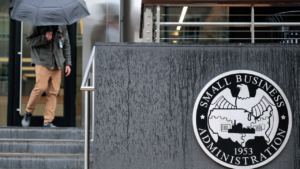The best and worst states for SBA 7(a) loans in 2023

Key takeaways
SBA 7(a) loans are a valuable source of funding for businesses. For the 2023 fiscal year — which ended September 30 — the SBA approved over 57,000 loans. Total loans amounted to more than $27.52 billion, with an average loan amount of $479,685.
SBA loans offer easier approvals and larger loan amounts than many other types of business loans. We’ll break down the best and worst states in the nation for people looking to get SBA 7(a) loans and discuss the loans that have been approved in each state.
The best states for SBA 7(a) loan approval
The SBA 7(a) Summary Report publishes data about SBA loan approvals, breaking down approvals using a variety of categories. For example, you can see approvals by gender of the applicant, business size, whether the company is rural or urban or by state.
We looked at data for approvals in the 2023 fiscal year to compile this list.
1. California
Total number of approvals: 6,109
Total loan amount: $3.63 billion
It’s no surprise that California is the number one state on this list. It has a strong reputation for innovative businesses and is also the most populous state in the nation. Borrowers in the state have raked in 13.2 percent of the SBA’s loans this year. This is down slightly from 2022 when California accounted for 14 percent of SBA borrowing.
California’s population represents 11.7 percent of the U.S., according to the U.S. Census Bureau, so they’re borrowing above their weight. But when you account for the high cost of living and related high costs of business, the large amount of borrowing is understandable.
-
- Live Oak Bank
- U.S. Bank
- Newtek Small Business Finance
2. Texas
Total number of approvals: 4,094
Total loan amount: $2.82 billion
The Lone Star State is the next biggest borrower of SBA loans, taking in just under $2.82 billion. That’s 10.2 percent of the total amount lent through the SBA 7(a) program in 2023. Like California, Texas is highly populous, representing about 9.01 percent of the American population. It also has a high growth rate, coming in as the fourth fastest-growing state, and is home to the best place to live in the U.S., Round Rock.
Texas consistently ranks in the top five states for SBA lending. In 2022, the state took in 10.9 percent of the SBA’s funds, with businesses receiving just over $2.8 billion in SBA 7(a) loans.
-
- Live Oak Bank
- Wallis Bank
- Huntington National Bank
3. Florida
Total number of approvals: 4,623
Total loan amount: $2.23 billion
If you’ve noticed a trend by now, you shouldn’t be surprised that Florida, the Sunshine State, is number three on this list. The third-most-populous state in the U.S., with 6.62 percent of the population, took in 8.1 percent of the SBA’s total lending in 2023. It’s also one of the best states for retirees.
Florida is another state experiencing significant population growth, increasing by 1.90 percent, making it the fastest-growing state at the end of 2022. It’s also a consistently high ranker in SBA loan statistics. In 2022, it received $1.953 billion in SBA loans, about 7.6 percent of the SBA’s lending for the year.
-
- TD Bank
- Newtek Small Business Finance
- Live Oak Bank
4. New York
Total number of approvals: 4,092
Total loan amount: $1.26 billion
New York, the fourth-most populated state in the country, is number four on the list, taking in $1.26 billion in SBA loans in 2023. But this is a big drop from Florida, the number three ranked state, which brought in about $970 million more this year. The average loan in Florida totaled just over $482,707, while the average loan in New York was just $308,505.
New York typically falls in the top ten but has much lower borrowing rates than other states. In 2022, companies in the state received SBA loans totaling $1.06 billion, roughly half the amount Floridian companies did.
-
- TD Bank
- Manufacturers and Traders Trust Company
- FinWise Bank
5. Georgia
Total number of approvals: 1,686
Total loan amount: $1.18 billion
Georgia is the first state on this list to break the trend of high-population states getting the most funding. Georgia is the eighth-most populous state in the country, with 3.25 percent of the population, but accounts for 4.3 percent of the SBA’s 7(a) loan funds.
The state is a consistently high performer. In 2022, it received the fourth-highest amount of funds from the SBA at $1.16 billion. It also tends to have large loans on average, with an average loan size of $699,600, dwarfing the overall average of $479,685
-
- Live Oak Bank
- Metro City Bank
- First IC Bank
The worst states for SBA 7(a) loan approval
Not every state gets a lot of funding from the SBA 7(a) loan program. Here are the states that have borrowed the least.
1. North Dakota
Total number of approvals: 89
Total loan amount: $34.31 million
North Dakota is the lowest-ranking state by SBA loan funding, receiving 89 loans for a total of a bit more than $34 million. It’s not surprising that the state hasn’t seen many approvals, given its relatively low population.
The state consistently ranks at the bottom. In 2022, it only had approved loans totaling $35 million, a steep drop from the $85.4 million it received in 2021.
-
- Aspire Bank
- Alerus Financial, National Association
- Choice Financial Group
2. Vermont
Total number of approvals: 155
Total loan amount: $38.51 million
This small New England state ranks second-to-last in SBA lending in 2023, with just 155 approvals for the state’s 647,000+ residents. Its average loan totaled just $248,428, well below the overall average of $479,085.
This low rate of lending may make sense, given the geography of the state and its relatively low population density. The need to borrow large amounts to start a company in a big city just doesn’t exist in much of the state.
-
- MVB Bank
- Byline Bank
- Ledyard National Bank
3. Hawaii
Total number of approvals: 151
Total loan amount: $49.73 million
Hawaii may be a tropical paradise, but it may not feel that way for local businesses, which received the third-least amount of SBA lending of any state. Businesses on the islands received just 0.2 percent of SBA 7(a) loan funds despite having 4.03 percent of the nation’s population.
Hawaii is known for its high cost of living, which can make it difficult to start a new enterprise. But things might be looking up as this third-to-last ranking is a step up from the past two years, where it was ranked 50th out of the 50 states.
-
- Live Oak Bank
- Central Pacific Bank
- Newtek Small Business Finance
4. Wyoming
Total number of approvals: 65
Total loan amount: $52.04 million
The Cowboy State rounds out the bottom of the list, bringing in over $51 million in 2023. Though it has beautiful mountain views, the state doesn’t set any records for SBA borrowing, receiving just 0.2 percent of the program’s funds.
While Wyoming’s ranking is a step below its fifth-worst ranking in 2022, the state surpassed the $48 million in SBA 7(a) loans it brought in last year.
-
- Live Oak Bank
- Newtek Small Business Finance
- Exos Small Business Lending
5. West Virginia
Total number of approvals: 156
Total loan amount: $53.78 million
West Virginia is a mountainous, sparsely populated state that hasn’t seen much in funding for the SBA loan program. The state moved from being the eighth-worst state for SBA funding in 2022 to the fifth position for 2023. It accounts for just 0.2 percent of the SBA loan funding in 2023, a minuscule number compared to California’s 13.2 percent.
-
- Huntington National Bank
- GBank
- Live Oak Bank
How to get an SBA 7(a) loan
The SBA doesn’t offer loans directly. Instead, it partners with lenders that want to offer SBA loans. The SBA insures loans, reducing the lenders’ risk and allowing them to offer easier approvals and larger loan amounts. And since the SBA sets a maximum rate that lenders can charge, SBA interest rates can be much lower than traditional and high-risk loans.
The first step in getting an SBA loan is finding a lender. One way to do this is through the SBA’s Lender Match, which can help you find lenders in your area. You can also contact lenders to see if they offer SBA loans.
Applying for an SBA loan can take some time, and you’ll need to meet various requirements regarding business size and ability to repay the debt. Submit your application, along with any supporting documents, and wait for the lender to make an approval decision.
High-risk loans are an option for business owners with bad credit and businesses that have not been operating long. You can find them with online lenders, though some banks and nonprofits may also offer financing to risky borrowers, especially those in underserved communities.
Alternatives to SBA 7(a) loans
SBA 7(a) loans are just one source of funding available to small businesses, but they’re not perfect for all situations. You can also consider these alternatives, which may be a better fit for your needs.
SBA microloans
SBA microloans are loans for amounts less than $50,000. The average loan is $13,000, according to the SBA. They often take less time to get than a 7(a) loan due to their smaller amount and can be used for most purposes, like working capital, inventory and machinery purchases. Compared to other types of SBA loans, approval rates for microloans are more favorable for underserved and minority communities. In 2021, Nearly 41% of the 4,400 microloans (totaling $71.8 million) went to underserved communities.
Business lines of credit
A line of credit is far more flexible than a 7(a) loan, giving your business access to a pool of cash that it can pull from as needed. You only pay interest on your outstanding balance. If you have unpredictable funding needs, a line of credit can offer flexibility. But like most business loans, line of credit rates can get high depending on factors like creditworthiness and time in business.
Working capital loans
Working capital loans are designed specifically for companies facing a cash crunch. That means they usually offer quick approvals and funding, something that SBA loans typically don’t. These may be a better fit if you need quick cash to cover a shortfall or take advantage of an opportunity.
Business credit cards
A business credit card is another type of short-term financing. They often have perks you won’t find with most loans. This includes cash back or other rewards and interest-free financing for short periods. If you can’t pay your balance in full each month and have great credit, a low-interest business loan could be a better option that could save you money.
Invoice financing or factoring
Invoice financing or factoring lets you get paid for invoices more quickly instead of waiting for your customers to pay up. The main benefit is that they’re usually easy to qualify for as long as your invoiced clients have good credit and a history of paying on time. But they can be expensive because you usually give up a percentage of each invoice’s value.
Merchant cash advances
A merchant cash advance is a type of short-term loan you can use for business-related issues like buying inventory or covering a short-term cash shortfall. You pay the loan back automatically by sending a percentage of each day’s sales to the lender.
MCAs are one of the most accessible types of business loans for bad credit. Approval rates are higher than many other types of loans, including SBA loans. But interest rates are also high, and you could end up in a cycle of debt if you can’t pay the loan off quickly.
Bottom line
SBA 7(a) loans can be a valuable source of funding for small businesses. Regardless of where you live, if an SBA loan could help you start or expand your company, consider applying for one or another type of business credit.
Frequently asked questions
-
In 2022, Live Oak Bank was the largest SBA lender, originating 1,517 loans for a total of $2.291 billion, an average of just over $1.5 million per loan. Huntington National originated the most SBA loans at 4,534, for a total of $914.4 million.
-
To get an SBA 7(a) loan, you must have sufficient revenue to pay the new loan. At the same time, you must qualify as a small business, which means remaining below revenue limits that vary by industry. For example, general automotive repair businesses can’t make more than $9 million annually, according to the SBA size standards. The SBA offers an interactive tool for learning more about size standards by industry.
-
The typical down payment requirement for an SBA 7(a) loan ranges from 10 percent to 30 percent.
Why we ask for feedback Your feedback helps us improve our content and services. It takes less than a minute to complete.
Your responses are anonymous and will only be used for improving our website.






